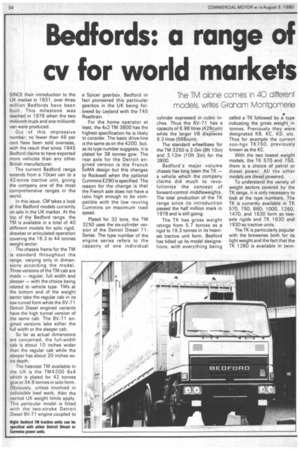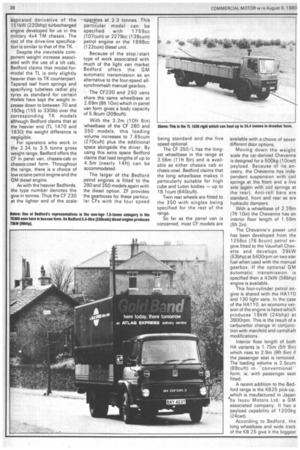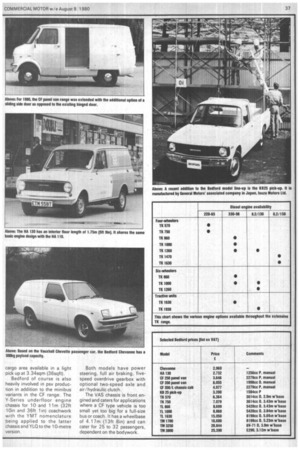Bedfords: a range of or for world markets
Page 36

Page 37

Page 38

Page 39

If you've noticed an error in this article please click here to report it so we can fix it.
SINCE their introduction to the UK market in 1931, over three million Bedfords have been built. This milestone was reached in 1 978 when the two millionth truck and one millionth van were produced.
Out of this impressive number, no fewer than 46 per cent have been sold overseas, with the result that since 1945 Bedford claims to have exported more vehicles than any other British manufacturer.
The current Bedford range extends from a lOcwt van to a 42-tonne tractive unit, giving the company one of the most comprehensive ranges in the world.
In this issue, CM takes a look at the Bedford models currently on sale in the UK market. At the top of the Bedford range, the TM is available in a total of 40 different models for solo rigid, drawbar or articulated operation covering the 16.3 to 44 tonnes weight sector.
The chassis frame for the TM is standard throughout the range, varying only in dimen sions according the model. Three versions of the TM cab are made — regular, full width and sleeper with the choice being related to vehicle type. TMs at the bottom end of the weight sector take the regular cab in its low tunnel form while the 6V-71 Detroit Diesel engined variants have the high tunnel version of the same cab. The 8V-71 engined versions take either the full width or the sleeper cab.
So far as actual dimensions are concerned, the full-width cab is about 10 inches wider than the regular cab while the sleeper has about 20 inches extra depth.
The heaviest TM available in the UK is the TM4200 6x4 which is plated for 42 tonnes gcw or 34.8 tonnes in solo form. Obviously, unless involved in indivisible load work, then the normal UK weight limits apply. This particular model is fitted with the two-stroke Detroit Diesel 8V-71 engine coupled to
a Spicer gearbox. Bedford in fact pioneered this particular gearbox. in the UK being followed by Leyland with the T45 Roadtrain.
For the home operator at least, the 4x2 TM 3800 has the highest specification he is likely to consider. The basic drive-line is the same as on the 4200, but, as its type number suggests, it is plated for 38 tonnes gcw. The rear axle for the Detroit engined version is the French SoMA design but this changes to Rockwell when the optional Cummins E290 is specified. The reason for the change is that the French axle does not have a ratio high enough to be compatible with the low revving Cummins on maximum road speed.
Plated for 32 tons, the TM 3250 uses the six-cylinder version of the Detroit Diesel 71Series. The type number of the engine series refers to the capacity of one individual cylinder expressed in cubic inches. Thus the 6V-71 has a capacity of 6.98 litres (426cuin) while the larger V8 displaces 9.3 litres (568cuin).
The standard wheelbase for the TM 3250 is 3.0m (9ft 10in) and 3.12m (10ft 3m) for the 3800.
Bedford's major volume chassis has long been the TK — a vehicle which the company claims did much to revolutionise the concept of forward-control middleweights. The total production of the TK range since its introduction passed the half million mark in 1978 and is still going.
The TK has gross weight ratings from 5.7 tonnes as a rigid to 19.3 tonnes in its heaviest tractive unit form. Bedford has tidied up its model designations, with everything being called a TK followed by a type indicating the gross weight_ in tonnes. Previously they were designated KB, KC, KD, .etc. Thus for example the current non-hgv TK750, previously known as the KC.
With the two lowest weight models, the TK 570 and 750, there is a choice of petrol or diesel power. All the other models are diesel powered.
To understand the variety of weight sectors covered by the TK range, it is only necessary to look at the type numbers. The TK is currently available in TK 570, 750, 860, 1000, 1260, 1470, and 1630 form as twoaxle rigids and TK 1630 and 1930 as tractive units.
The TK is particularly popular with the breweries both for its light weight and the fact that the TK 1260 is available in twin steer form to ease the axle weight problems associated with a diminishing load.
Three basic diesel engine designs are listed for the TK from the four-cylinder 3.6-litre (220cuin) 220-65 unit in the TK 570 up to the 150 horsepower version of the 8.2-litre (500cuin) Blue Series engine.
Added to this engine choice is a wide range of transmission options. There are no fewer than 14 gearboxes — Bedford, Eaton or Turner — with at least three choices of axle ratio for most models and two-speed axles available in many cases. The Turner T5-300 gearbox has a choice of ratio spread and, like the heavier T5-400 can be specified with direct or overdrive top.
The wheelbase options are many and various but, as a guideline, the 16-ton TK 1630 chassis has a choice of five ranging from 3.76m (12ft 4in) up to 5.69m (18ft 8in).
On the braking side, the smallest of the range, the TK 570 has hydraulic/vacuum servo brakes while the rest of the TK range use an air/hydraulic system. Spring parking brakes are standard again with the exception of the 570 which has a mechanical system operating on the rear wheels.
Recently Bedford announced the TL range, which many had expected to replace the longserving TK. In fact the new ange is produced in addition to _
the TIC which has increased the model overlap already apparent in certain sectors of the Bedford market coverage. In the 16-ton two-axle rigid category, an operator can choose a TK, a TL or a TM in varying degrees of specification.
The TL covers the 5.7 to
16.3-tonne weight range in solo form with two tractive units being listed at 16.3 and 19.3 tonnes respectively. I he most powerful of the rigids is plated for drawbar operation at 24.4 tonnes if required;
Although the TL cab looks very similar to that of the TK, Bedford claims that there are no common pressings whatsoever. The main difference between the two is the tilt cab of the TL. This tilts to a maximum angle of 50 degrees which gives ample clearance for the complete engine to be lifted out if necessary. Bedford claims that tilting the cab should only be necessary for major overhauls as the hinged rear quarter valances of the type used on TK have been retained.
The choice of wheelbases for TL ranges from 2.92m (9ft 7in) to 5.69m (18ft 8in) permitting body lengths of 3.4 up to 6.7m (11 to 221t).
At the top end of the TL range the standard power unit in the 8.2-litre Blue Series engine which produces 112 kW (150bhp). This is a naturally aspirated derivative of the 151kVV (220bhp) turbocharged engine developed for us in the military 4x4 TM chassis. The rest of the drive-line specification is similar to that of the TK.
Despite the inevitable component weight increase associated with the use of a tilt cab, Bedford claims that model-formodel the TL is only slightly heavier than its TK counterpart. Tapered leaf front springs and specifying tubeless radial ply tyres as standard for certain models have kept the weight increase down to between 70 and 150kg (155 to 330Ib) over the corresponding TK models although Bedford claims that at the heavier end (TL 1470 and 1630) the weight difference is negligible.
For operators who work in the 2.34 to 3.5 tonne gross weight range, Bedford offers the CF in panel van, chassis-cab or chassis-cowl form. Throughout the range, there is a choice of low octane petrol engine and the GM diesel engine.
As with the heavier Bedfords, the type number denotes the gvw in tonnes. Thus the CF 230 at the lighter end of the scale• operates at 2.3 tonnes. This particular model can be specified with 17 59cc (107cuin) or 2279cc (139cuin) petrol engine or the 1998cc (122cuin) diesel unit.
Because of the stop/start type of work associated with much of the light van market Bedford offers the GM automatic transmission as an alternative to the four-speed allsynchromesh manual gearbox.
The CF230 and 250 vans share the same wheelbase at 2.69m (8ft 10in) which in panel van form gives a body capacity of 5.9cum (208cuft).
With the 3.2m (10ft 6in) wheelbase of the CF 280 and 360 models, this loading volume increases to 7.65cum (270cuft) plus the additional space alongside the driver, By using this extra space Bedford claims that load lengths of up to 4.5m (nearly 14ft) can be accommodated.
The larger of the Bedford petrol engines is fitted to the 280 and 350 models again with the diesel option. ZF provides the gearboxes for these particular CFs with the four speed being standard and the five speed optional.
The CF 350/1_ has the longest wheelbase in the range at 3.56m (11ft 8in) and is available as either chassis cab or chasis cowl. Bedford claims that the long wheelbase makes it particularly suitable for high cube arid Luton bodies — up to 18.1cum (640cuft).
Twin rear wheels are fitted to the 350 with singles being specified for the rest of the range.
So far as the panel van is concerned, most CF models are available with a choice of seven different door options.
Moving down the weight scale the car-derived Cheyenne is designed for a 500kg (10cwt) payload. Because of its ancestry, the Cheyenne has independent suspension with coil springs at the front and a live axle (again with coil springs at the rear). Anti-roll bars are standard, front and rear as are hydraulic dampers.
With a wheelbase of 2.39m (7f1 10in) the Cheyenne has an interior floor length of 1.59m (5ft 2in).
The Chevanne's power unit has been developed from the 1256cc (76.6cuin) petrol engine fitted to the Vauxhall Chevette and develops 39kVV (53bhp) at 5400rpm on two star fuel when used with the manual gearbox. If the optional GM automatic transmission is specified then a 42kVV (56bhp) engine is available.
This four-cylinder petrol engine is shared with the HA110 and 130 light vans. In the case of the HA110, an economy version of the engine is listed which produces 18kW (24bhp) at 3800rpm. This is the result of a carburettor change in conjunction with manifold and camshaft modifications.
Interior floor length of both HA variants is 1.75m (5ft 9in) which rises to 2.9m (9ft 6in) if the passenger seat is removed. The loading volume is 2,5cum (88cuft) in ''conventional'' form, ie, with passenger seat fitted.
A recent addition to the Bedford range is the KB25 pick-up, which is maufactured in Japan by isuzu Motors Ltd, a GM associated company. It has a payload capability of 1200kg (24cwt).
According to Bedford, the long wheelbase and wide track of the KB 25 give it the biggest cargo area available in a light pick up at 3.34sqm (36sqft).
Bedford of course is also heavily involved in psv production in addition to the minibus variants in the CF range. The Y-Series underfloor engine chassis for 10 and 11m (32ft 10in and 36ft 1in) coachwork with the YMT nomenclature being applied to the latter chassis and YLCt to the 10-metre version, Both models have power steering, full air braking, fivespeed overdrive gearbox with optional two-speed axle and air/hydraulic clutch.
The VAS chassis is front engined and caters for applications where a CF type vehicle is too small yet too big for a full-size bus or coach. It has a wheelbase of 4.17m (13ft 8in) and can cater for 25 to 32 passengers, dependent on the bodywork.












































































































